Skills and Tools for Nurse Leaders in Quality Management
VerifiedAdded on 2022/09/14
|5
|959
|25
Report
AI Summary
This report examines the pivotal role of nurses in leading healthcare quality improvement initiatives. It emphasizes the importance of nurses possessing both clinical expertise and strong leadership skills to ensure safe, effective, and affordable patient care. The report highlights critical thinking and interpersonal skills as essential for making sound decisions, fostering collaboration, and applying evidence-based practices like root cause analysis and PDSA cycles. It underscores the use of tools such as flowcharts, policies, work schedules, and shift reports to facilitate quality management. The report uses the example of bedside care, illustrating how these skills and tools can be applied to improve patient outcomes, reduce hospital-acquired infections, and minimize readmissions. The ultimate aim is to improve healthcare delivery and patient satisfaction through effective nurse leadership.
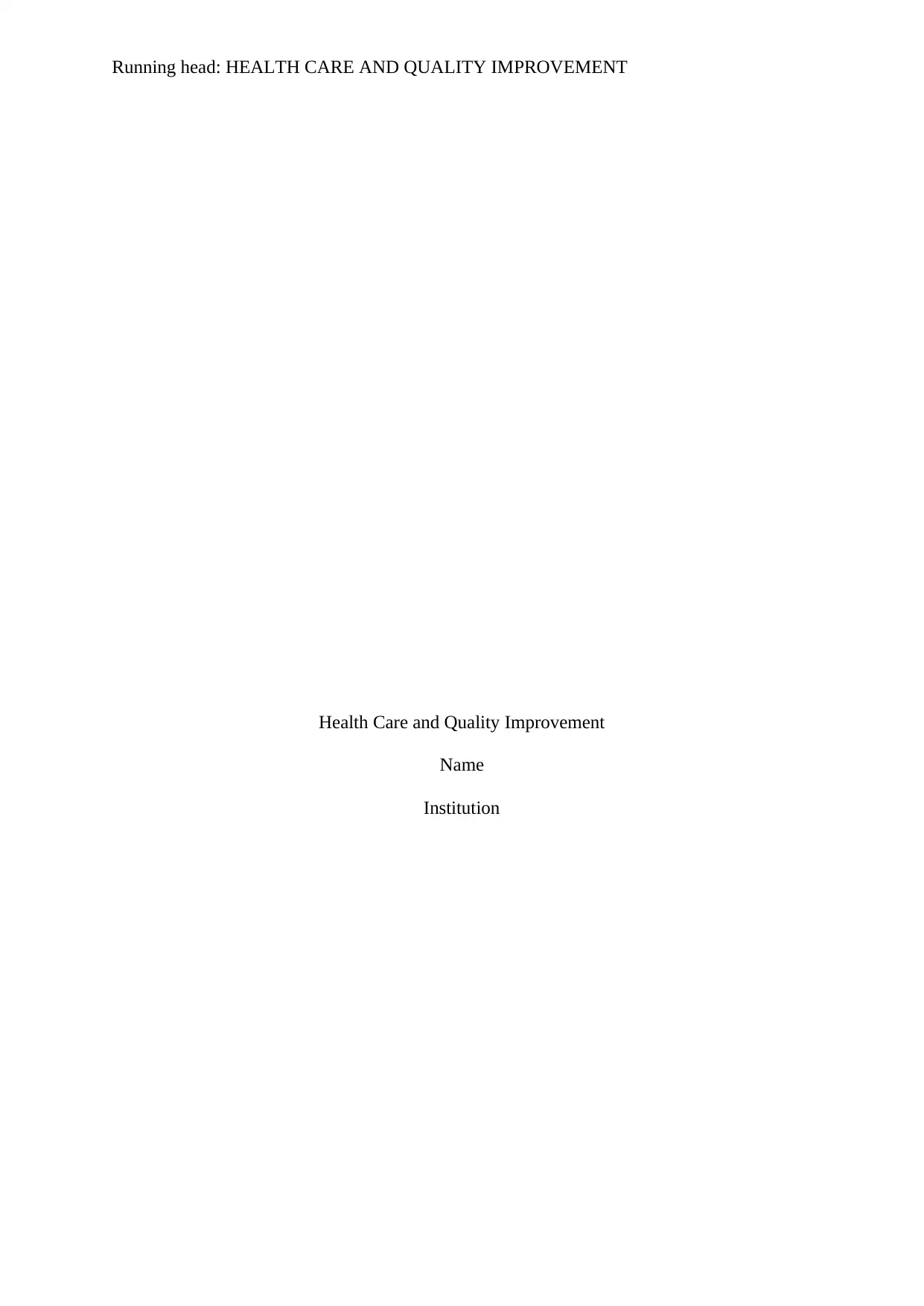
Running head: HEALTH CARE AND QUALITY IMPROVEMENT
Health Care and Quality Improvement
Name
Institution
Health Care and Quality Improvement
Name
Institution
Paraphrase This Document
Need a fresh take? Get an instant paraphrase of this document with our AI Paraphraser
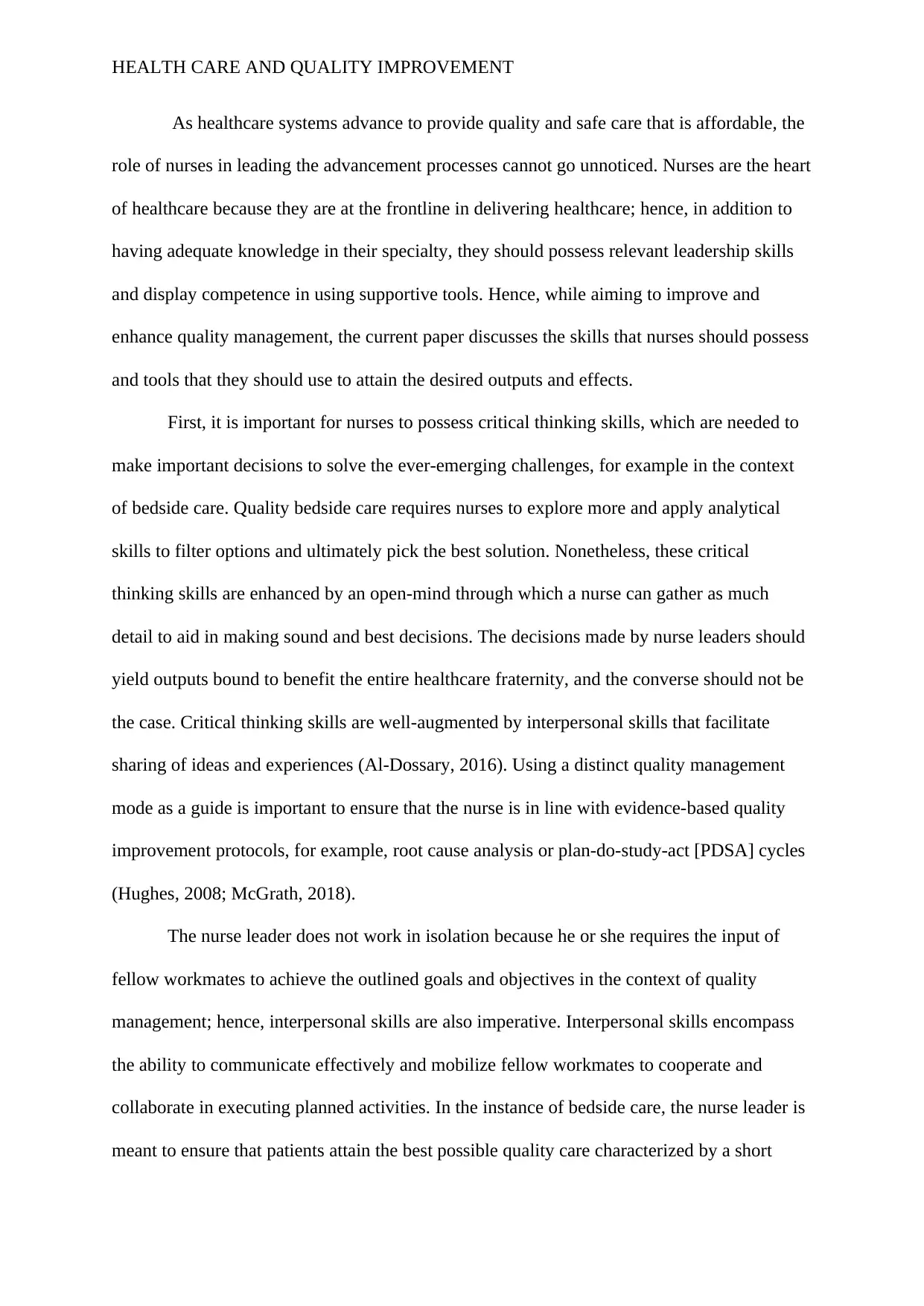
HEALTH CARE AND QUALITY IMPROVEMENT
As healthcare systems advance to provide quality and safe care that is affordable, the
role of nurses in leading the advancement processes cannot go unnoticed. Nurses are the heart
of healthcare because they are at the frontline in delivering healthcare; hence, in addition to
having adequate knowledge in their specialty, they should possess relevant leadership skills
and display competence in using supportive tools. Hence, while aiming to improve and
enhance quality management, the current paper discusses the skills that nurses should possess
and tools that they should use to attain the desired outputs and effects.
First, it is important for nurses to possess critical thinking skills, which are needed to
make important decisions to solve the ever-emerging challenges, for example in the context
of bedside care. Quality bedside care requires nurses to explore more and apply analytical
skills to filter options and ultimately pick the best solution. Nonetheless, these critical
thinking skills are enhanced by an open-mind through which a nurse can gather as much
detail to aid in making sound and best decisions. The decisions made by nurse leaders should
yield outputs bound to benefit the entire healthcare fraternity, and the converse should not be
the case. Critical thinking skills are well-augmented by interpersonal skills that facilitate
sharing of ideas and experiences (Al-Dossary, 2016). Using a distinct quality management
mode as a guide is important to ensure that the nurse is in line with evidence-based quality
improvement protocols, for example, root cause analysis or plan-do-study-act [PDSA] cycles
(Hughes, 2008; McGrath, 2018).
The nurse leader does not work in isolation because he or she requires the input of
fellow workmates to achieve the outlined goals and objectives in the context of quality
management; hence, interpersonal skills are also imperative. Interpersonal skills encompass
the ability to communicate effectively and mobilize fellow workmates to cooperate and
collaborate in executing planned activities. In the instance of bedside care, the nurse leader is
meant to ensure that patients attain the best possible quality care characterized by a short
As healthcare systems advance to provide quality and safe care that is affordable, the
role of nurses in leading the advancement processes cannot go unnoticed. Nurses are the heart
of healthcare because they are at the frontline in delivering healthcare; hence, in addition to
having adequate knowledge in their specialty, they should possess relevant leadership skills
and display competence in using supportive tools. Hence, while aiming to improve and
enhance quality management, the current paper discusses the skills that nurses should possess
and tools that they should use to attain the desired outputs and effects.
First, it is important for nurses to possess critical thinking skills, which are needed to
make important decisions to solve the ever-emerging challenges, for example in the context
of bedside care. Quality bedside care requires nurses to explore more and apply analytical
skills to filter options and ultimately pick the best solution. Nonetheless, these critical
thinking skills are enhanced by an open-mind through which a nurse can gather as much
detail to aid in making sound and best decisions. The decisions made by nurse leaders should
yield outputs bound to benefit the entire healthcare fraternity, and the converse should not be
the case. Critical thinking skills are well-augmented by interpersonal skills that facilitate
sharing of ideas and experiences (Al-Dossary, 2016). Using a distinct quality management
mode as a guide is important to ensure that the nurse is in line with evidence-based quality
improvement protocols, for example, root cause analysis or plan-do-study-act [PDSA] cycles
(Hughes, 2008; McGrath, 2018).
The nurse leader does not work in isolation because he or she requires the input of
fellow workmates to achieve the outlined goals and objectives in the context of quality
management; hence, interpersonal skills are also imperative. Interpersonal skills encompass
the ability to communicate effectively and mobilize fellow workmates to cooperate and
collaborate in executing planned activities. In the instance of bedside care, the nurse leader is
meant to ensure that patients attain the best possible quality care characterized by a short
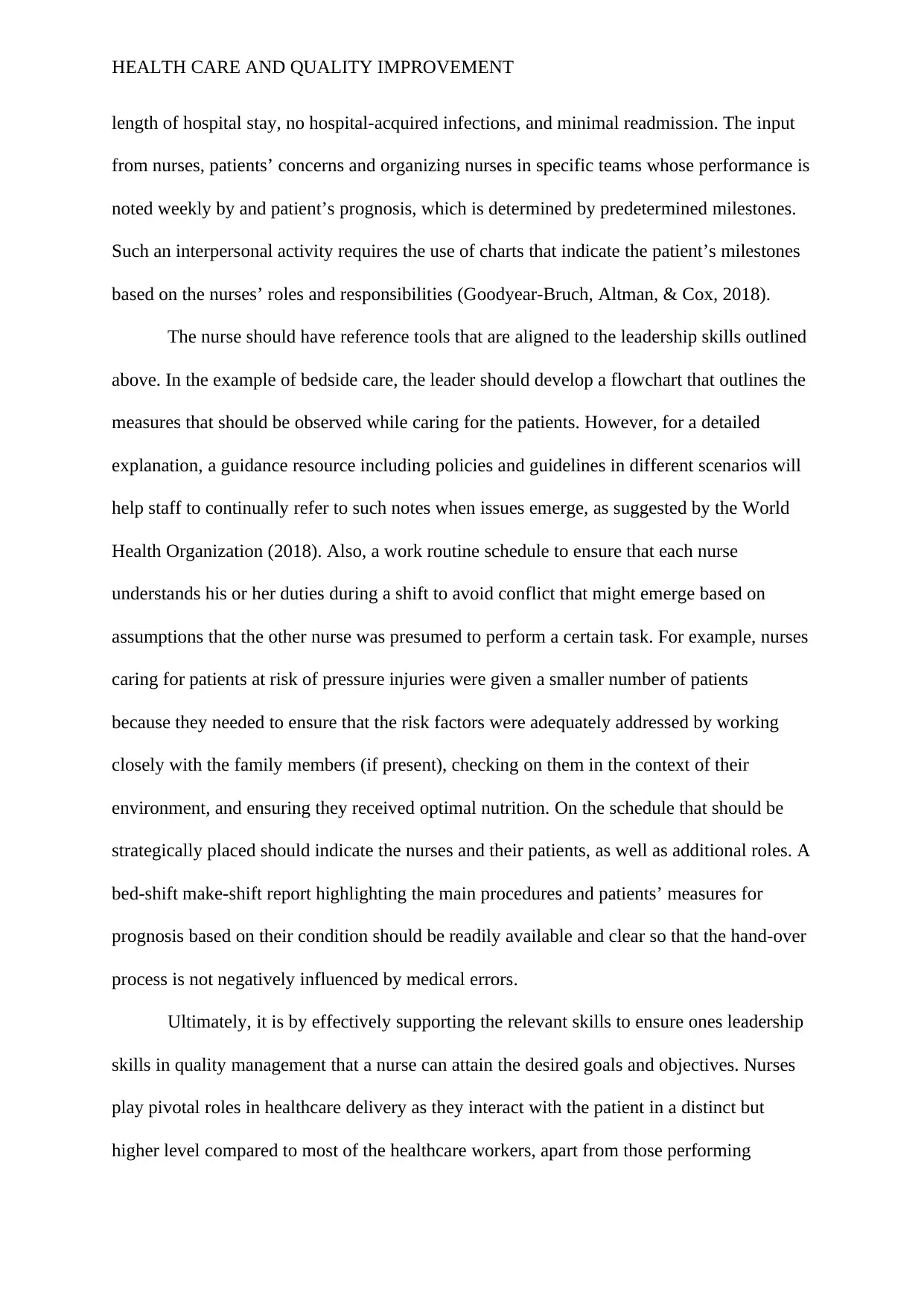
HEALTH CARE AND QUALITY IMPROVEMENT
length of hospital stay, no hospital-acquired infections, and minimal readmission. The input
from nurses, patients’ concerns and organizing nurses in specific teams whose performance is
noted weekly by and patient’s prognosis, which is determined by predetermined milestones.
Such an interpersonal activity requires the use of charts that indicate the patient’s milestones
based on the nurses’ roles and responsibilities (Goodyear-Bruch, Altman, & Cox, 2018).
The nurse should have reference tools that are aligned to the leadership skills outlined
above. In the example of bedside care, the leader should develop a flowchart that outlines the
measures that should be observed while caring for the patients. However, for a detailed
explanation, a guidance resource including policies and guidelines in different scenarios will
help staff to continually refer to such notes when issues emerge, as suggested by the World
Health Organization (2018). Also, a work routine schedule to ensure that each nurse
understands his or her duties during a shift to avoid conflict that might emerge based on
assumptions that the other nurse was presumed to perform a certain task. For example, nurses
caring for patients at risk of pressure injuries were given a smaller number of patients
because they needed to ensure that the risk factors were adequately addressed by working
closely with the family members (if present), checking on them in the context of their
environment, and ensuring they received optimal nutrition. On the schedule that should be
strategically placed should indicate the nurses and their patients, as well as additional roles. A
bed-shift make-shift report highlighting the main procedures and patients’ measures for
prognosis based on their condition should be readily available and clear so that the hand-over
process is not negatively influenced by medical errors.
Ultimately, it is by effectively supporting the relevant skills to ensure ones leadership
skills in quality management that a nurse can attain the desired goals and objectives. Nurses
play pivotal roles in healthcare delivery as they interact with the patient in a distinct but
higher level compared to most of the healthcare workers, apart from those performing
length of hospital stay, no hospital-acquired infections, and minimal readmission. The input
from nurses, patients’ concerns and organizing nurses in specific teams whose performance is
noted weekly by and patient’s prognosis, which is determined by predetermined milestones.
Such an interpersonal activity requires the use of charts that indicate the patient’s milestones
based on the nurses’ roles and responsibilities (Goodyear-Bruch, Altman, & Cox, 2018).
The nurse should have reference tools that are aligned to the leadership skills outlined
above. In the example of bedside care, the leader should develop a flowchart that outlines the
measures that should be observed while caring for the patients. However, for a detailed
explanation, a guidance resource including policies and guidelines in different scenarios will
help staff to continually refer to such notes when issues emerge, as suggested by the World
Health Organization (2018). Also, a work routine schedule to ensure that each nurse
understands his or her duties during a shift to avoid conflict that might emerge based on
assumptions that the other nurse was presumed to perform a certain task. For example, nurses
caring for patients at risk of pressure injuries were given a smaller number of patients
because they needed to ensure that the risk factors were adequately addressed by working
closely with the family members (if present), checking on them in the context of their
environment, and ensuring they received optimal nutrition. On the schedule that should be
strategically placed should indicate the nurses and their patients, as well as additional roles. A
bed-shift make-shift report highlighting the main procedures and patients’ measures for
prognosis based on their condition should be readily available and clear so that the hand-over
process is not negatively influenced by medical errors.
Ultimately, it is by effectively supporting the relevant skills to ensure ones leadership
skills in quality management that a nurse can attain the desired goals and objectives. Nurses
play pivotal roles in healthcare delivery as they interact with the patient in a distinct but
higher level compared to most of the healthcare workers, apart from those performing
⊘ This is a preview!⊘
Do you want full access?
Subscribe today to unlock all pages.

Trusted by 1+ million students worldwide
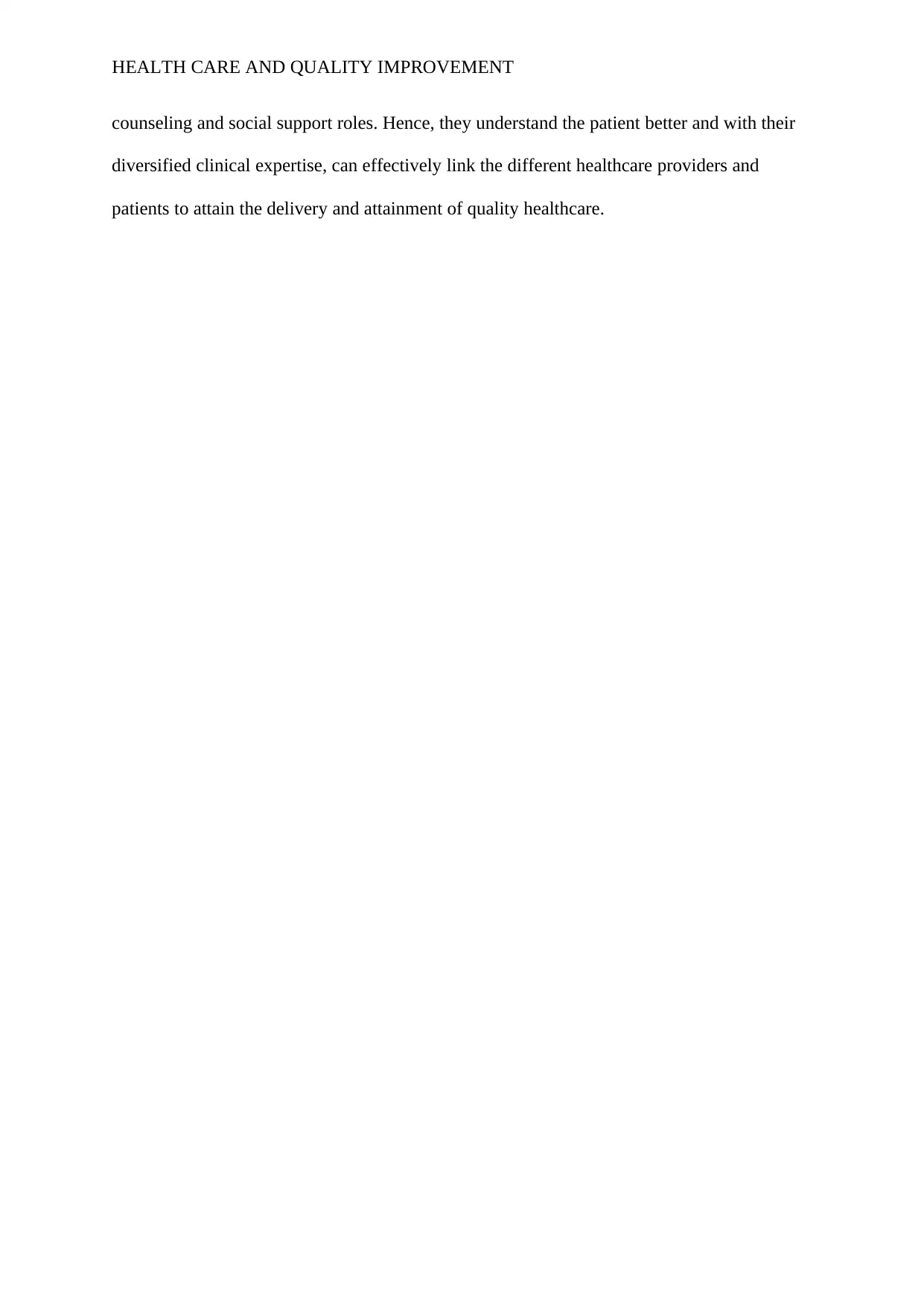
HEALTH CARE AND QUALITY IMPROVEMENT
counseling and social support roles. Hence, they understand the patient better and with their
diversified clinical expertise, can effectively link the different healthcare providers and
patients to attain the delivery and attainment of quality healthcare.
counseling and social support roles. Hence, they understand the patient better and with their
diversified clinical expertise, can effectively link the different healthcare providers and
patients to attain the delivery and attainment of quality healthcare.
Paraphrase This Document
Need a fresh take? Get an instant paraphrase of this document with our AI Paraphraser
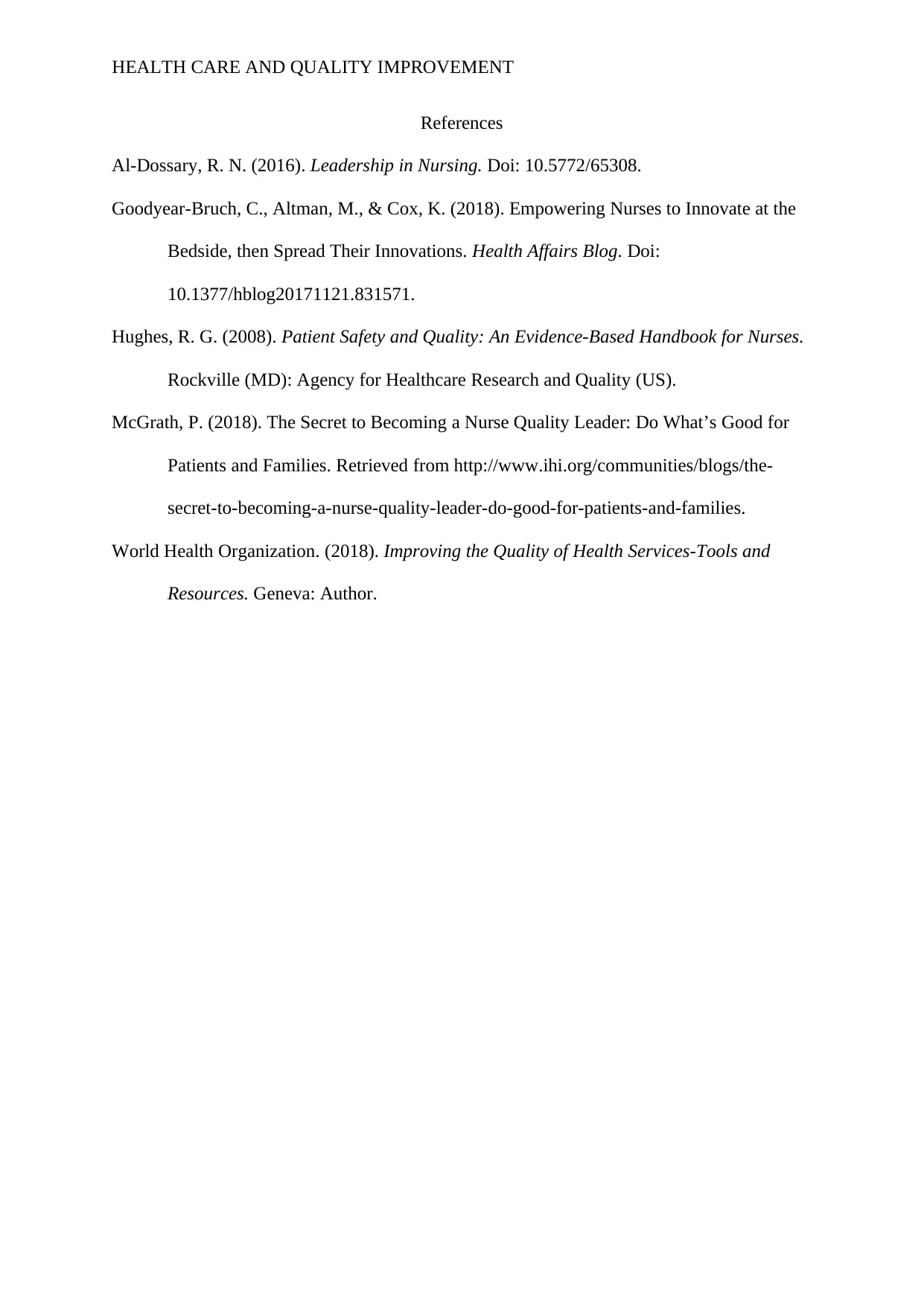
HEALTH CARE AND QUALITY IMPROVEMENT
References
Al-Dossary, R. N. (2016). Leadership in Nursing. Doi: 10.5772/65308.
Goodyear-Bruch, C., Altman, M., & Cox, K. (2018). Empowering Nurses to Innovate at the
Bedside, then Spread Their Innovations. Health Affairs Blog. Doi:
10.1377/hblog20171121.831571.
Hughes, R. G. (2008). Patient Safety and Quality: An Evidence-Based Handbook for Nurses.
Rockville (MD): Agency for Healthcare Research and Quality (US).
McGrath, P. (2018). The Secret to Becoming a Nurse Quality Leader: Do What’s Good for
Patients and Families. Retrieved from http://www.ihi.org/communities/blogs/the-
secret-to-becoming-a-nurse-quality-leader-do-good-for-patients-and-families.
World Health Organization. (2018). Improving the Quality of Health Services-Tools and
Resources. Geneva: Author.
References
Al-Dossary, R. N. (2016). Leadership in Nursing. Doi: 10.5772/65308.
Goodyear-Bruch, C., Altman, M., & Cox, K. (2018). Empowering Nurses to Innovate at the
Bedside, then Spread Their Innovations. Health Affairs Blog. Doi:
10.1377/hblog20171121.831571.
Hughes, R. G. (2008). Patient Safety and Quality: An Evidence-Based Handbook for Nurses.
Rockville (MD): Agency for Healthcare Research and Quality (US).
McGrath, P. (2018). The Secret to Becoming a Nurse Quality Leader: Do What’s Good for
Patients and Families. Retrieved from http://www.ihi.org/communities/blogs/the-
secret-to-becoming-a-nurse-quality-leader-do-good-for-patients-and-families.
World Health Organization. (2018). Improving the Quality of Health Services-Tools and
Resources. Geneva: Author.
1 out of 5
Related Documents
Your All-in-One AI-Powered Toolkit for Academic Success.
+13062052269
info@desklib.com
Available 24*7 on WhatsApp / Email
![[object Object]](/_next/static/media/star-bottom.7253800d.svg)
Unlock your academic potential
Copyright © 2020–2025 A2Z Services. All Rights Reserved. Developed and managed by ZUCOL.





